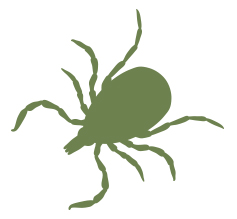BY TIMOTHY J. GIBB

It is tick talk time. When I say “tick talk,” I am not referring to a timekeeping device, such as a watch or a clock. I am simply pointing out it is the best time to discuss ticks and their potential danger.
Most people have had the disagreeable experience of finding a tick attached to their skin — or worse, finding it sucking their blood. These are never pleasant experiences, but tick dangers go well beyond just being a nuisance; well beyond being gross, disgusting and unpleasant; well beyond just the mark or the itchy welt that is left behind. Tick bites are potentially life-altering.
Ticks transmit several very serious diseases to people as well as pets and other animals. It is important to know how, when and where ticks appear and how diseases are transmitted so that you can avoid them, prevent them from biting where possible and deal with them if they do bite. Talking about ticks now will increase your protection and peace of mind.
Here are 10 tips for individuals who want to enjoy time spent out in nature but not join the ticks’ lunch group.
• Be aware of where and when black-legged ticks are active.
• Discourage ticks from biting by wearing insect repellent (DEET), especially from May through July.
• Permethrin applied to shoes and pants kills or stuns ticks that touch the treated fabric, thus providing additional protection.
• Circumvent ticks that drop onto shoes from crawling to bare skin by wearing long pants and shirt sleeves and by tucking your pants into your socks. This outfit may raise eyebrows from fashion-conscious friends and neighbors, but if you carry along a golf club or bag, they will probably just shrug and forget all about it.
• Use veterinary-prescribed tick control measures on pets.
• Thoroughly check yourself for ticks when you come in from the outdoors. Remember that the ticks may be quite small.
• Wear light-colored clothing so that the ticks are most obvious to the naked eye.
• A quick, soapy shower will wash off ticks if they have not already cemented themselves onto your skin.
• Ticks must be attached for at least 36 hours to spread Lyme disease, so remove ticks as soon as possible by pulling them straight out with tweezers.
• Request a blood test from your doctor if you develop a fever, unusual headaches, fatigue, neck pain, or stiffness in muscles and joints after being in tick-infested areas. A red, bulls-eye shaped rash at the site of the bite is sometimes diagnostic.
TIMOTHY J. GIBB is a clinical professor in the Entomology Department at Purdue University.



